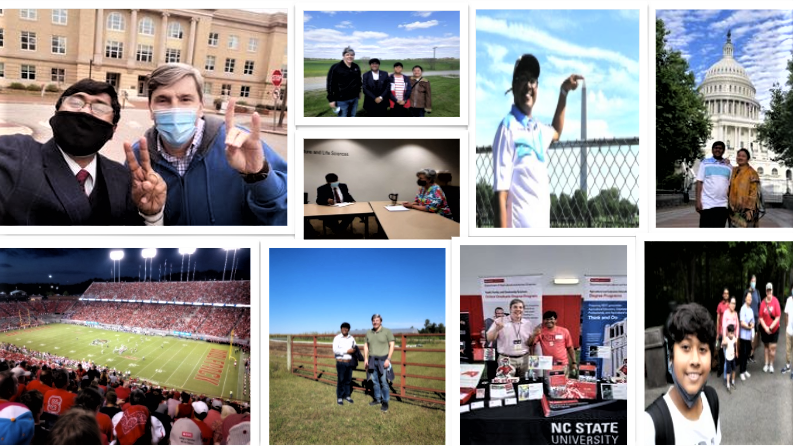
WRITTEN BY: Alex Gordon, tagordo2@ncsu.edu
On November 3, 2021, CALS International Programs and CALS SAIGE were happy to host Dr. Mohammad Golam Farouque as part of their monthly international seminar series. Farouque is a Fulbright Visiting Scholar at the Department of Agricultural and Human Sciences (AHS) in NC State’s College of Agricultural and Life Sciences. He previously served as Head Professor of the Department of Agricultural Extension Education at Bangladesh Agricultural University’s College of Agriculture from 2012-2014, and has a wealth of other experience in the field, including extensive work in Japan.
The title of Dr. Farouque’s presentation was “Building Bridges between NC State and Bangladesh Agricultural University through Academic and Research Collaborations.” This description is comprehensive, as well as quite fitting, as the ensuing presentation was all about collaboration. Dr. Farouque opened the presentation with two quotes, the first of which was this: “Learn to interact with people who are different from you. It makes you a better human being.” The second of the quotes was as follows: “Unity is strength….When there is teamwork and collaboration, wonderful things can be achieved.” The former quote comes from Rupert Nacoste, NC State Alumnus and Distinguished Undergraduate Professor of Psychology, while the latter belongs to Mattie J. T. Stepanek, Poet, peacemaker and philosopher (1990-2004).
After the opening quotes, Dr. Farouque proceeded to show a collection of photographs by the name of “Panoramic View of Experiences as a Fulbright Visiting Scholar.” These pictures showed Dr. Farouque himself visiting other universities such as the University of Tennessee and Virginia Tech as well as landmarks like the Washington Monument and the US Capitol Building. One photo included him attending a football game at Carter Finley stadium. Following the display of the photographs, he gave a detailed explanation of the concept of collaboration, then a definition of the concept of international collaboration (IC): “A universal mode of interaction between two or more countries based on sharing research results, production, commerce, protection of investments and industrial know-how.”
Much of the following content of the presentation was compiled of a series of lists regarding collaboration. Dr. Farouque first listed the three main areas of common collaboration in higher education institutes, namely Education, Research, and Community/Industry. He then stressed the global importance of collaboration and listed several benefits of it. After a few more relevant lists, he addressed potential challenges before moving on to the other major component indicated in the presentation’s title, aside from collaboration itself in general: building bridges between NC State and Bangladesh Agricultural University (BAU).
Dr. Farouque outlined the major objectives of building bridges between the two universities before offering a breakdown of BAU itself. The institution was established in Bangladesh in 1961 as the only university of its kind and has 43 academic departments under 6 colleges. Its vision is to produce quality graduates in the field of crop, livestock, and fisheries sectors, and its missions are to develop the art and science of agriculture for the well-being of mankind, educate agriculturists of high standards and scientific managerial and professional competence in harmony with the environment, and share knowledge and skills with the world. Since its founding it has produced more than 42,000 agricultural graduates, and it remains committed to education, extension and research.
BAU has two centres–the BAU Extension Centre and the Germplasm Centre, the latter of which is the world’s second largest, with about 8,500 mother plants of 161 species. The university also has four major institutes, those being the Graduate Training Institute (GTI), the Interdisciplinary Institute for Food Security (IIFS), the Institute for Agribusiness and Development Studies (IADS), and the Haor and Char Development Institute (HCDI). The latter of these is concerned with the study of two significant types of ecosystems in Bangladesh. These are, as the name suggests, haor and char.
Haor is a wetland ecosystem that is physically a bowl-shaped shallow depression. This type of ecosystem receives surface runoff waters from rivers and canals to become vast stretches of turbulent water during monsoons. 15.3% of total rice cultivation area (about 1.74 million hectares) in Bangladesh comes from haors. Char, in contrast, refers to tracts of land surrounded by the waters of rivers, and they can be considered a “byproduct” of the hydro-morphological dynamics of rivers. These chars, both island and attached, are being consistently formed by erosion and accretion, and they often give rise to new settlements and agricultural opportunities. Today, about 17 million people live in 8000 sq km of char areas in Bangladesh. Thus, haor and char are ecosystems that are crucial to Bangladesh’s agricultural development in different ways.
Following the comprehensive breakdown of BAU and its fields of study, Dr. Farouque moved to comparisons between BAU and NC State. He listed both of their potentials as well as their most pressing challenges, with each corresponding set being quite similar to each other. Next came the list of benefits for both faculty and students, followed by the outlining of a framework for collaboration. Everything in this outline was intended to lead to the stimulation of higher education and research through collaboration.
To wrap up the presentation, Dr. Farouque stated the intended impacts of a partnership between BAU and NC State. The short-term goal is the creation of a virtual study abroad program. As for mid-term goals, research on climate change assessments and feeding the future application for fund management were given. Finally, the long-term goals are the MOU linking of the two universities and enhancement of global learning and posterity. In conclusion, Dr. Farouque then presented an extensive list of both opportunities and risks for the partnership before graciously thanking the presentation’s hosts and attendees.